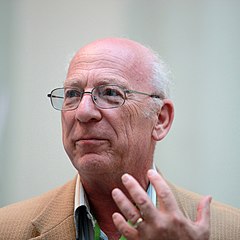Barry Trost
Barry Martin Trost | |
|---|---|
 Barry M. Trost in June 2012 | |
| Born | 13 June 1941 (age 80) |
| Nationality | American |
| Alma mater | University of Pennsylvania B.S. (1963) Massachusetts Institute of Technology Ph.D. (1965) |
| Known for | Tsuji-Trost reaction, Trost ligand, Atom economy |
| Awards | ACS Award in Pure Chemistry (1977) Arthur C. Cope Award (2004) The Ryoji Noyori Prize (2013) Linus Pauling Award (2015) |
| Scientific career | |
| Fields | Organic Chemistry |
| Institutions | University of Wisconsin–Madison Stanford University |
| Thesis | The Structure and Reactivity of Enolate Anions (1965) |
| Doctoral advisor | Herbert O. House |
| Doctoral students | Brian Coppola Michael J. Krische F. Dean Toste |
Barry M. Trost (born June 13, 1941 in Philadelphia) is an American chemist who is the Job and Gertrud Tamaki Professor Emeritus in the School of Humanities and Sciences at Stanford University.[1] The Tsuji-Trost reaction and the Trost ligand are named after him. He is prominent for advancing the concept of atom economy.[2][3]
Early life and education[]
Trost was born in Philadelphia, Pennsylvania on June 13, 1941. He studied at the University of Pennsylvania and obtained his B.A. in 1962.[4] He then attended the Massachusetts Institute of Technology for graduate school, where he worked with Prof. Herbert O. House enolate anions, the Mannich reaction, and the Robinson annulation.[5][6][7] Trost graduated with his Ph.D. in 1965.
Independent career[]
Trost moved to the University of Wisconsin–Madison to begin his independent career, and was promoted to Professor of Chemistry in 1969, and the Vilas Research Professor in 1982.[4] In 1987, he moved to Stanford University as Professor of Chemistry, and was appointed the Job and Gertrud Tamaki Professor of Humanities and Sciences in 1990. He previously served as Chair of the Department of Chemistry.[4]
References[]
- ^ "Barry Trost | Department of Chemistry". chemistry.stanford.edu. Retrieved 2021-05-24.
- ^ Trost, Barry M. (1991). "Atom Economy: A Search for Synthetic Efficiency". Science. 254 (5037): 1471–1477. Bibcode:1991Sci...254.1471T. doi:10.1126/science.1962206. PMID 1962206.
- ^ Trost, Barry M. (1995). "Atom Economy - A Challenge for Organic Synthesis: Homogeneous Catalysis Leads the Way". Angewandte Chemie International Edition. 34 (3): 259–281. doi:10.1002/anie.199502591.
- ^ Jump up to: a b c Trost, Barry M.; Toste, F. Dean; Pinkerton, Anthony B. (2001-06-19). "Non-Metathesis Ruthenium-Catalyzed C−C Bond Formation". Chemical Reviews. 101 (7): 2067–2096. doi:10.1021/cr000666b. ISSN 0009-2665.
- ^ House, Herbert O.; Trost, Barry M. (1964-06-01). "The Mannich Reaction with 2-Methylcyclopentanone and 2-Methylcyclo hexanone1a". The Journal of Organic Chemistry. 29 (6): 1339–1341. doi:10.1021/jo01029a016. ISSN 0022-3263.
- ^ House, Herbert O.; Trost, Barry M. (1965-05-01). "The Chemistry of Carbanions. IX. The Potassium and Lithium Enolates Derived from Cyclic Ketones1". The Journal of Organic Chemistry. 30 (5): 1341–1348. doi:10.1021/jo01016a001. ISSN 0022-3263.
- ^ House, Herbert O.; Trost, Barry M.; Magin, Ralph W.; Carlson, Robert G.; Franck, Richard W.; Rasmusson, Gary H. (1965-08-01). "By-products of the Robinson Annelation Reaction with Cyclohexanone, Cyclopentanone, and Cyclopentane-1,2-dione1". The Journal of Organic Chemistry. 30 (8): 2513–2519. doi:10.1021/jo01019a004. ISSN 0022-3263.
- 21st-century American chemists
- Organic chemists
- 1941 births
- Scientists from Philadelphia
- University of Pennsylvania alumni
- Living people
- Members of the United States National Academy of Sciences
- Massachusetts Institute of Technology alumni
- Stanford University faculty
- University of Wisconsin–Madison faculty
- American chemist stubs